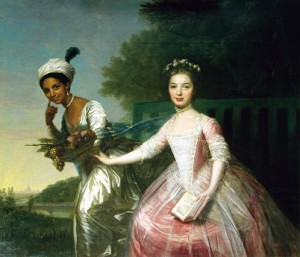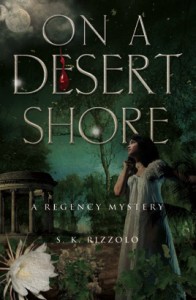 Relevant History welcomes historical mystery author S. K. Rizzolo, who earned an MA in literature before becoming a high school English teacher and author. Her Regency mystery series features a trio of crime-solving friends: a Bow Street Runner, an unconventional lady, and a melancholic barrister. On a Desert Shore is the fourth title in the series following The Rose in the Wheel, Blood for Blood, and Die I Will Not. Rizzolo lives in Los Angeles. To learn more about her and her books, visit her web page, and follow her on Facebook, Goodreads, and Google+.
Relevant History welcomes historical mystery author S. K. Rizzolo, who earned an MA in literature before becoming a high school English teacher and author. Her Regency mystery series features a trio of crime-solving friends: a Bow Street Runner, an unconventional lady, and a melancholic barrister. On a Desert Shore is the fourth title in the series following The Rose in the Wheel, Blood for Blood, and Die I Will Not. Rizzolo lives in Los Angeles. To learn more about her and her books, visit her web page, and follow her on Facebook, Goodreads, and Google+.
*****
Readers of Georgette Heyer’s Regency novels are familiar with her references to skin care products such as Denmark Lotion or Olympian Dew. A young lady’s fair and blooming complexion could be almost as critical to her success as her dowry and social position. Then, as now, those with unsightly spots sought to avoid embarrassment. But the ideal of complexion went much deeper than that. It was, in fact, tied to anxieties about Britain’s Empire, notions of proper Englishness, and the desire to maintain boundaries of class and race.
In my novel On a Desert Shore, Marina Garrod receives every advantage of the privileged young lady. Rumored to be the heiress to vast wealth, she debuts in Society with the hope of making an eligible alliance. But to bigoted eyes, there’s a problem. All her father’s money cannot make her into a genuine “English Rose” (pink cheeks and red lips with pale skin)—for Marina is the daughter of a Jamaican planter and his slave-housekeeper. My novel is about Marina’s plight in the England of 1813, a time when attitudes toward race were hardening, in part because of growing fears of cultural and racial contamination./p>
A Rose By Any Other Complexion…
Marina’s experience as a mixed-race heiress in Georgian England was not unique. In his dissertation Children of Uncertain Fortune: Mixed Race Migration from the West Indies to Britain, 1750-1820, Dan Livesay estimates that, by the end of the 18th century, as many as a quarter of rich Jamaicans with children of color sent them home to England to live in a free society. On the whole these children were the lucky ones who had escaped the astoundingly brutal and oppressive sugar island. Still, families sometimes challenged the inheritances of their mixed-race kin, and the position of these young people would have been equivocal at best. It’s difficult to imagine how they might have felt. While Britain had halted its participation in the slave trade in 1807, slavery itself endured for several more decades in the colonies. Apologists for the institution like Marina’s father failed to justify a practice that was increasingly seen, according to the poet Samuel Taylor Coleridge, as “blotched all over with one leprosy of evil.” Here Coleridge refers to the arguments of West India merchants and slave owners, calling them “cosmetics” designed to conceal a horrible reality.
Deirdre Coleman asserts that the British public of the day had a “fascination with complexion.” And my research revealed that this was especially true of white Creole women (Creole is an ambiguous term that sometimes meant the Blacks of Jamaica and sometimes a person of any race who had spent a lot of time there). I encountered stories of the white Creole women’s attempts to preserve their complexions so that when they returned to England they could bloom into legitimate English roses. They wore elaborate sunshades and even flayed their skin with the caustic oil of the cashew nut! Often they created what even some contemporaries called an artificial and unhealthy pallor.
Why such rigid standards of beauty? This was a society in which all-powerful white men exploited black women at their own whim and will, a society in which wives were often confronted with the humiliating results of open infidelity—their husbands’ slave children. It was important to the Creole ladies, whose skin could become tanned or weathered in the tropical climate, to maintain strict boundaries through their complexions. In other words, “whiteness” as a marker of status and breeding. But, ironically in this racially mixed society, it might not be possible to determine someone’s precise background just by looking. There might have been little visible difference between a Creole lady and her husband’s mulatta or quadroon concubine.
Performing Gentility
When a woman named Janet Schaw traveled to North America and the West Indies between 1774–76, she wrote in her diary about putting on and off her delicacy “like any piece of dress.” To me, this points to the performative aspect of femininity. A woman can don a mask of beauty and gentility to further her ends or play her role in society. This is precisely what Marina cannot do to her tormenters’ satisfaction. And yet she is not afraid to express her fellow feeling with African slaves or her contempt for slavery. You will have to read the book to find out what happens after her failed London season. In essence, she is shipwrecked “on a desert shore” in an alien land, even though she is half English and has been mostly reared in England. She is no true English rose.
 Here’s the famous portrait of Dido Elizabeth Belle and her cousin Lady Elizabeth Murray. Belle was the daughter of an enslaved African woman and Sir John Lindsay, a British naval officer. After Lindsay brought his daughter to England, she lived with the Earl of Mansfield, the Lord Chief Justice, at Kenwood House in Hampstead. Much speculation has arisen in regard to this portrait, whose artist is uncertain. Why does Belle point at her own cheek in a curiously awkward gesture? Perhaps she calls attention to her contrasting complexion in order to suggest that any difference is only “skin deep.”
Here’s the famous portrait of Dido Elizabeth Belle and her cousin Lady Elizabeth Murray. Belle was the daughter of an enslaved African woman and Sir John Lindsay, a British naval officer. After Lindsay brought his daughter to England, she lived with the Earl of Mansfield, the Lord Chief Justice, at Kenwood House in Hampstead. Much speculation has arisen in regard to this portrait, whose artist is uncertain. Why does Belle point at her own cheek in a curiously awkward gesture? Perhaps she calls attention to her contrasting complexion in order to suggest that any difference is only “skin deep.”
There’s an unforgettable scene in another novel, an anonymous abolitionist work of 1808 called The Woman of Colour, which introduces Olivia Fairfield, the natural daughter of a West Indian planter and a slave. Like Marina Garrod, Olivia travels to England. In the scene a curious little boy at a tea party compares his hand to Olivia’s, interrogating her about her skin color. Her response: “The same God that made you made me…[as well as my servant Dido, a] poor black woman—the whole world—and every creature in it! A great part of this world is peopled by creatures with skins as black as Dido’s, and as yellow as mine…”
Which leaves us with one of my favorite Shakespearean sonnets, a satiric poem making the point that, after all, what we deem beauty has nothing to do with outward show. After criticizing his beloved for her varied imperfections, including the lack of “roses” in her cheeks, the speaker says: “And yet, by heaven, I think my love as rare / As any she belied with false compare.”
*****
 A big thanks to S. K. Rizzolo. She’ll give away a copy of On a Desert Shore to someone who contributes a comment on my blog this week. I’ll choose the winner from among those who comment by Friday at 6 p.m. ET. Delivery is available worldwide for an ebook and in the U.S., Canada, and Europe for a hardcover.
A big thanks to S. K. Rizzolo. She’ll give away a copy of On a Desert Shore to someone who contributes a comment on my blog this week. I’ll choose the winner from among those who comment by Friday at 6 p.m. ET. Delivery is available worldwide for an ebook and in the U.S., Canada, and Europe for a hardcover.
**********
Did you like what you read? Learn about downloads, discounts, and special offers from Relevant History authors and Suzanne Adair. Subscribe to Suzanne’s free newsletter.

The issue of race has always been perplexing. Words were developed to specify the quantity of non-white inheritance a person had as you indicated. While race remains a social reality, there is no consistent genetic difference between the races at all.
The issue perplexes and saddens me too. The social constructs have been and continue to be incredibly powerful–as, of course, the words we use are too. In the book, I deliberately did not specify my character Marina’s precise skin tone because, to me, that wasn’t the point. Thank you for the thoughtful comment!
seems we have made no progress in this issue of race or colour
I agree that it can often seem that way. Just have to read the news these days…
This sounds like a fascinating book! That curious portrait makes me wonder about the Lady Murray’s hand. Is she enclosing or pushing away her cousin?
I wondered about that too. Does Elizabeth restrain her cousin playfully, or reach out with an affectionate hand? And why does Belle point at her own cheek in that rather strange gesture? Certainly, she is off center and poised to the side in this portrait, as if she’s not fully integrated into her privileged world. Thanks for the comment, Norma!
I agree! It looks as if she’s pushing her out of the picture, but Belle can’t be denied. It does make me wonder about the artist, and his (??? Probably a him) relationship with the two women. Now there’s a mystery!
Still, while it’s a fascinating bit of history, it makes me nuts that we’re still having the same social conversation today, especially around girls and beauty. Crazy-making!
It makes me crazy too–this kind of thing never seems to end for women. It seems likely the artist is a man, though I believe the attribution is uncertain. I’d love to know how he handled the sittings with the two women. Perhaps the basket of fruit is meant to suggest that Belle has domestic duties whereas her cousin does not? Ironically, Belle’s expression is more lively and compelling. She looks mischievous to me.
Oh, yeah, Belle steals the show! She looks much more alive and real than her cousin. Love that.
It’s interesting that nowadays, when biracial families are becoming so common that most of us no longer even notice variations in skin color, there is such a surge in racism among certain groups of “white” people. Generally, those seem to be people who have never had much social contact with members of other races and who live rather insular lives. Based on my travels, England deals with this issue better than the U.S., but then slavery was pretty much relegated to the British colonies, while it was embedded in American culture from the beginning. Maybe one day we Yanks will recognize that we are a nation comprised entirely of immigrants (with the exception of Native Americans), and that not all of those immigrants were white-skinned northern Europeans. Our concept of beauty today encompasses a wide range of racial characteristics — if only our concept of human value did the same.
Beautifully said, Laurie! To value everyone in the society is the only way. And I agree with you that England has less tragic baggage in regard to slavery than the U.S., though I believe that historians have now begun to examine the history of English families that profited directly from the slave trade and were thus able to create landed estates. When slavery itself was abolished in the British empire in the 1830s, slave owners who lived in Britain were paid vast sums in compensation. I remember looking at the website that documents these payments and learning that ordinary middle class people received the payment (including single women and widows). So it wasn’t just the truly wealthy plantation owners and “nabobs,” as they called them in that day, who profited.
Several years ago, my husband and I visited West Africa, including countries where the slave trade flourished. We were especially moved by the “door of no return” in many of the fortresses along the coast from which people were loaded onto slave ships, never to see their homes and families again. Coming from a Southern family, many of whom were slave-holders on a small scale before the Civil War (not to minimize their sin), I believe that anyone who romanticizes life in the antebellum South should have to stand in one of those doors of no return and look back toward beautiful Africa and then out toward the empty sea. Slavery is a blot on the history of western civilization that can never be erased. Thank you, Ms. Rizzolo, for casting new light on this important topic.
Your story reminds me of an artifact in the new Museum of African American History in D.C. (the N.Y. Times has some incredible photos). The artifact is a pillowcase embroidered by a woman named Rose, who gave it to her 9-year-old daughter just before the child was sold. This child’s granddaughter later embroidered this story of loss on the pillowcase so that her family’s history could be preserved. There’s something so sad and yet so uplifting about that.
Here’s the link in case anyone wants to view the exhibit:
http://www.nytimes.com/interactive/2016/09/15/arts/design/national-museum-of-african-american-history-and-culture.html?_r=0
Laurie, I agree: blot, stain, wound. No words are too strong to describe the wrong that slavery caused.
Thanks so much for the touching comment.
This sounds like a very interesting book, and written about a subject that is rarely brought up in many historical romances. I’d love a chance to win this.
Thanks for the comment, Jody. And best of luck to you!
I really enjoyed reading the comments. This book sounds like an intriguing one that I have added to my TBR list.
I am always looking for new authors to read.
Thank you so much, Joye. I appreciate your interest!